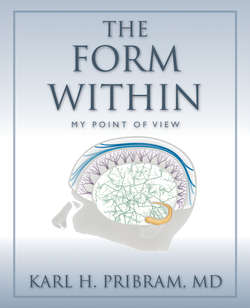Читать книгу The Form Within - Karl H Pribram - Страница 9
На сайте Литреса книга снята с продажи.
Form as Shape and Form as Pattern
ОглавлениеBoth form as shape and form as pattern have roots in early Greek mathematics. Today we associate form as shape with the name Euclid, who wrote the first known axiomatic theory (a theory based on a few assumptions from which propositions are logically deduced). Euclid’s assumptions were devoted to geometry. We were taught Euclid’s geometry in high school and we are thus familiar with it. In geometry (that is, earth-metrics) we measure—in the British system—what is in our Yards as we pace them with our Feet, or in the case of the height of horses, with our Hands. Geometry is a hands-on way of out-lining shapes. In Euclid’s geometry, parallel lines do not meet.
By contrast, form as pattern is today associated with the name Pythagoras. Pythagoras is an elusive figure who is known principally through the writings of the “school” he founded. We are currently acquainted with Pythagoras through trigonometry, the study of tri-angles that are archetypes, “forms or patterns from which something develops.“ The term “archetypes” is derived from tepos, “tapping.” Pythagoras noted that tapping pieces of metal of different sizes gave rise to different sounds. He later noticed that, in a similar fashion, tapping taut strings of different lengths gave rise to oscillations in the string that appeared as waves. Different sounds were produced by strings of different lengths. A string divided in two gives rise to sounds an octave higher than the original. Measurement of the length of strings that give rise to different sounds could be ordered, that is given ciphers or numbers. From the archetype of waving strings, music was derived.
The cyclic oscillations of the strings that appear as waves vary in frequency (density) according to the length
of the oscillating strings. An insight that seems ordinary to us but has had to be repeatedly achieved anew is that the wave-forms can also be represented by a circle: perhaps noted by the Pythagoreans as the form taken by sand spread lightly on the surface of a drum. Achieving this seminal insight will be encountered on several occasions in the chapters of The Form Within. But we come across it first with Pythagoras.
Thus, once the circle form is recognized, numbers can be assigned to different parts of the circle. Pythagoras did this by forming a tri-angle within the circle, a triangle one of whose angles rests on a point on the circle. Arranging the numbers within a cycle as a circle allowed Pythagoras to tri-angulate (as in trigonometry) a location on the circle and describe the location by its angles (by way of their sine and cosine). These angles could measure contexts beyond those that we can lay our hands on: Go to the nearest railroad track— the tracks do not obey the Euclidean postulate that parallel lines do not meet. Rather the tracks appear to meet at an angle near the horizon which forms a circle.
Pythagoras had therefore two number systems available: the frequency or density of the wave-forms and the numbers forming each cycle.
Note again that geometry develops an active, out-lining method of measurement that is limited in the range being investigated. By contrast, relationships among numbers engage an in-formative, an imaginative and inventive proactive procedure (as in trying to assess the meaning of the apparent convergence of railroad tracks at our horizon). Form as shape and form as pattern have led to two very different ways of guiding our approach to the world we navigate.
In the succeeding chapters of The Form Within, I describe a newer, still different type of formulation: proactive, dynamical “self-organizing” processes that occur in our brains and lead to progressively refining our observations, and thus to refining the targets of our actions and the diversity of our perceptions. This is the very essence of both the humanities and the sciences.
Sounds forbidding? It is. But accompany me on this fascinating and amazing journey and you may be surprised at how comprehensible the many facets of this three-pound universe have become today. And how an intimate knowledge of your brain will affect the way you transform your world.
